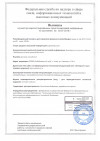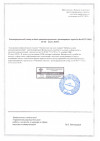Резюме
| Название статьи | ЭКСТРАСИСТОЛИЯ У ДЕТЕЙ: СОВРЕМЕННЫЕ ВЗГЛЯДЫ НА ВОЗМОЖНЫЕ ПРИЧИНЫ |
|---|---|
| Категория | Номер 4 за 2016 год |
| Ключевые слова | дети, экстрасистолия, этиология. |
| Скачать | Скачать статью |
| Резюме |
Пшеничная Е.В., Тонких Н.А., Конопко Н.Н.* ЭКСТРАСИСТОЛИЯ У ДЕТЕЙ: СОВРЕМЕННЫЕ ВЗГЛЯДЫ НА ВОЗМОЖНЫЕ ПРИЧИНЫ Донецкий национальный медицинский университет им. М. Горького, г. Донецк ГБОУ ВПО Тверской государственный медицинский университет, г. Тверь
Резюме: В статье приведены данные литературы о возможных причинах возникновения экстрасистолии у детей, согласно которым данный вид аритмии является мультифакториальной патологией, имеющей кардиальные и экстракардиальные причины. Согласно данным собственного исследования, НРСиП выявлены у 802 детей обоего пола от 2 недель до 18 лет. Экстрасистолию имели 62,7% детей, из них 61,0% пациентов с различными заболеваниями (врожденными пороками сердца и магистральных сосудов, первичной кардиомиопатией, активным воспалительным процессом в миокарде, диафрагмальной грыжей, врожденной аномалией проводящей системы сердца, вегетативной дисфункцией), лечение которых сопровождалось позитивной динамикой аритмического синдрома, клинических данных, показателей инструментального и лабораторного обследования, что явилось основанием считать их этиопатогенетически значимыми в возникновении ЭС; у 39,0% детей данного контингента констатирована идиопатическая экстрасистолия. Ключевые слова: дети, экстрасистолия, этиология.
Pshenichnaya E.V., Tonkykh N.A., Konopko N.N. * EXTRASYSTOLE IN CHILDREN: CURRENT VIEWS ON THE POSSIBLE CAUSES Donetsk national medical university of M. Gorky, Donetsk Tver state medical university* Abstract. The most common arrhythmia in children still remains extrasystole (ES). Its specific weight in the structure of arrhythmias only in the last decade increased from 4 % to 75%. It is known that the fact of detection of ES is not always evidence of disease. The frequency of detection ES depends on the method of registration, its type, age and state of health of patients. So, frequent finding when analyzing the daily ECG is a single ES. At 70-85 % of patients ES associated with different associated cardiac or extracardiac pathology, treatment of which determines the forecast of its clinical course congenital heart disease, primary cardiomyopathy, a disease of the endocardium, myocardium, pericardium, violation of the central regulation of heart rhythm, autonomic dysfunction, endocrine diseases, electro violations, acid-base disbalance. Heart rhythm disturbance in the form of ES can be one of the side effects of treatment with medication. We have analyzed the medical records 802 children of both sexes from birth to 18 years, the residents of Donetsk region which have been investigated or were on the observation of the polyclinic and the Department of pediatric cardiology, cardiac surgery and rehabilitation of «Institute of urgent and reconstructive surgery named. V.K. Husak». 503 (62,7±4,8 %) child of this group had the ES. According to the results of a comprehensive study, the 307 children (61,0±2,2%) has identified the following diseases: the congenital heart disease and arterial vessels (62 persons; 12,3±1,5%), primary cardiomyopathy (6 persons;; 1,2±0,5%), an active inflammatory process in the myocardium (46 persons; 9,1±1,3%), diaphragmatic hernia (2 persons; 0,4±0,3%), congenital anomaly of the cardiac conduction system (7 persons; 1,4±0,5%), autonomic dysfunction (184 persons; 36,6±2,1%). Treatment of concomitant diseases accompanied by positive dynamics arrhythmic syndrome, clinical data, indicators instrumental and laboratory examination, that allowed to consider them relevant in the development of arrhythmias. The 196 persons (118 boys, 78 girls) evidence of cardiac and extracardiac reasons ES using available methods were absent allowed to consider its idiopathic arrythmia; the share of such patients in the structure of children with ES amounted to 39,0±2,2%. Given the above, we can conclude that structural changes in the heart may occur earlier or simultaneously with functional, but never develop them later, so the absence of structural changes at the level of the organism does not exclude their presence at the cellular level. Thus, according to literature data and the results of individual research, extrasystole of children is a violation of the heart rhythm in the etiology of which take part cardiac and extracardiac factors. The most complicated in the prognosis and the treatment is idiopathic arrythmia. Taking into account the regularities of maturation of the autonomic nervous system in childhood, features contemporary of inflammatory processes in the myocardium, it is important to determine causal relationships that define triggers and leading etiological factors in each case. Key words: children, extrasystole, etiology
|
| Автор 1 | Пшеничная Елена Владимировна |
| Автор 2 | Тонких Наталья Александрова |
| Автор 3 | Конопко Наталья Николаевна |



